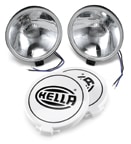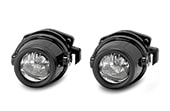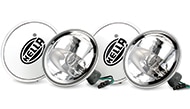Parabolic Reflector
The parabolic reflector with its highly reflective "silvered" surface is featured in many of today's lights. Parabolic reflectors have been used in automotive lighting systems almost since the introduction of the automobile, and have been refined during the last 90 years.
These reflectors feature the shape of a parabola (somewhat bowl-shaped) with the light source typically located at the reflector's focal point. This combination projects the light rays parallel to one another in a symmetrical pattern and can focus the available light into a tight beam. Moving the light source toward the reflector will spread the light, while moving the source of light away from the reflector will cause the light rays to converge.
The parabolic reflector is most efficient in applications that don't require sharp cut-offs (such as low-beam light patterns), but allow all of the reflector and lens size to be utilized. Larger parabolic reflectors project more light, making them ideal for applications that aren't restricted by available installation space.
DE light technology
The DE (triple-axle ellipsoid) light technology's principle is similar to that used in a slide projector. An ellipsoid as a reflector directs the light to a focusing lens that bundles it and projects it onto the road. A shield positioned between the reflector and the lens provides the prescribed cutoff. DE headlamps, a Hella innovation, are low in dazzle and are therefore ideal for low-beam and fog lamp use. Advantages in comparison with typical parabolic headlamps: smaller dimensions, almost twice the light output, clear cutoff, and hardly any scatter loss.
Hella produced projection headlamps under the name DE (triple-axle ellipsoid) for the first time in 1983 for aftermarket applications and then from 1986 onwards for original vehicle equipment. A favorable beam pattern can be achieved even in small-sized headlamps thanks to the relatively small projection lens.
FF light technology
FF (Free-Form or free-surface) light technology is the result of the reflector surface and bulb position being optimized by high-performance computers with a correspondingly high light output. FF light technology allows the reflector's surface to be calculated point by point to illuminate certain areas of the road. This lighting technology is clearly identified by the crystal clear cover lens that gives the headlamp its unmistakable character.
Utilization of the whole reflector surface and a pattern-free lens design has been made possible by the use of FF technology developed by Hella and used for the first time in series production in 1988. This advanced calculation technique has made it possible to achieve a favorable beam pattern solely produced by the shape of the reflector, leaving the cover lens with a purely protective function.
Was this post helpful?
339 of 1128 people found this post helpful




